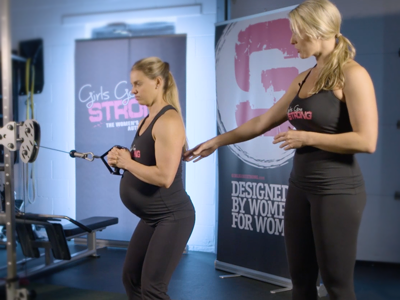Strength training in pregnancy is a form of physical activity that can be modified, exercise by exercise, to your client’s changing pregnant body, regardless of what stage of pregnancy she’s in. It can also help prepare her body to be better able to handle the physical stress of a progressing pregnancy and help to ward off back and pelvic pain.
Strength training can also give your client a sense of strength and power in her body at a time when she may feel out of control with how it’s changing. Additionally, studies have shown many benefits to babies of exercising moms, including better birth outcomes, healthy birth weights, and higher APGAR scores.1
Coaching pregnant fitness clients comes with a lot of responsibility.
As a trainer, some of the most important aspects of your job include: helping your pregnant clients feel normal in a time wrought with constant changes, ensuring they are feeling more comfortable in their body and not doing anything that might increase aches or pains, and helping them stay active throughout their pregnancy as long as possible for optimal physical, mental, and emotional health.
If you haven’t had much experience working with pregnant clients, despite having the best intentions and doing some reading, you may find yourself making some mistakes, likely without realizing it. The following are six common mistakes trainers make with pregnant clients, and how you can avoid making them.
1. Scaring instead of sharing.
As fitness professionals we need to educate our pregnant clients with information about their bodies that can help support them in their pregnancy (and postpartum) journey. It’s important to educate (and stay educated yourself) on topics such as diastasis recti, pelvic floor dysfunction, incontinence, pelvic organ prolapse. These topics might feel overwhelming, but they are essential for prenatal fitness trainers and clients to understand.
One of the most important things to keep in mind when educating a client is to take an approach of sharing, not scaring. Encourage your client to support her body as best as possible, take care of herself, honor what feels good and what does not, and to check her ego at the door during workouts.
Instead of putting the focus on what she can’t or shouldn’t do when pregnant with regard to exercise, turn the attention to all that she can do.
Prenatal fitness coaching isn’t about cutting out all the exercises someone loves to do for the next nine months. It’s about is helping the body function optimally, supporting the body’s changes throughout pregnancy, and preparing your client for postpartum recovery.
2. Getting caught up in the #fitpregnancy world.
Don’t get caught up in the “#fitpregnancy” world for the sake of fitness.
Check your intentions and the purpose of your prenatal fitness programming. Is it to make your client more comfortable? To keep her strong? To help her feel better?
Or, are you motivated to keep her lifting heavy for her entire pregnancy because those pictures or videos get a lot of Instagram likes? Is it to have her running until she’s 35 weeks pregnant because that “proves” how fit she is? Can you see the misplaced logic in these examples?
If you are working with the general fitness population — which includes moms who simply want to feel good in their bodies — emphasize exercise as a means for staying comfortable during pregnancy, for preparing for the physicality of parenting, and for good health.
3. Writing workouts that look the same across all trimesters.
There should be noticeable changes in the movement modifications, intensity, reps, and purpose of your exercise sessions through each trimester of pregnancy.
Be clear on your purpose.
Do your client’s workouts look exactly as they did before she was pregnant, even though she is now dealing with all-day sickness in her first trimester? Is she doing things like squat jumps for interval training in the third trimester?
What is the purpose of each exercise you include in a training program and how does each exercise fit into the big picture? It’s critical to adapt to the needs of your pregnant client based on how she is feeling every step of the way.
For example, perhaps in the first trimester you are encouraging your client to rest longer between each exercise and set as she is feeling incredibly fatigued. Yet, in the second trimester, her energy may be rebounding and you now have time at the end of the session to add an extra set of glute training exercises.
4. Keeping the intensity too low for your client’s fitness level, lifting experience, and interests.
Prenatal exercise is often portrayed in one of two ways: either too intense or not intense enough. At one end of the spectrum are pregnant women who believe they should engage primarily in low-intensity and leisurely movement like walking, yoga, and water-based activity. At the other end of the spectrum, we see some pregnant women who engage in intense CrossFit-like training, marathon running, and heavy lifting.
There is nothing inherently wrong with either of the examples above, but the majority of your pregnant clients are likely to benefit from training in the gray area between those two extremes.
Strength training is absolutely encouraged in pregnancy. The loads your client uses for many exercises will likely need to get lighter as her body changes, but do know that moderate lifting is very safe for pregnant women who are not presenting any contraindications to exercise.
Cardiovascular exercise and interval training workouts can be performed all throughout pregnancy if that is something your client wants to do and you are programming the specific workout to suit her body’s needs during every phase of her pregnancy.
Balance is the name of the game.
Establish balance between more and less intense exercise throughout each week. Determine how many times a week your client truly enjoys exercising and then fill in the gaps with lots of body movement on the other days. For example, perhaps your client strength trains two days a week and does an interval training session on another day. She participates in a prenatal yoga class once a week, she takes a longer leisurely walk every other day.
5. Not understanding what is happening to your client’s body, at a general level, in pregnancy and how that can affect training programming.
What is the body going through cardiovascularly, musculoskeletally, and hormonally in pregnancy? How does this affect exercise programming?
While you don’t need to go to graduate school to coach pregnant women, you do need to learn about what a woman’s body goes through during pregnancy, though.
Learn about the changes to the abdominal wall, the support structures of the pelvic floor, and how the hormonal changes affect the joints of the body. Understand that energy levels can change throughout pregnancy, that morning sickness can last all day long, and that your client might not even be able to think about eating a vegetable or piece of meat.
You have to get on her level to some degree. This doesn’t mean getting pregnant, but it does mean learning as much as you can about pregnancy.
6. Not paying enough attention to your client’s body alignment and breathing during exercise.
In pregnancy strength training it’s common for the body to not be in optimal alignment to support the core and pelvic floor. You will likely see your client’s ribcage thrusting upwards or her bum and tailbone tucked under, or a combination of both. Make sure she “stacks” her ribcage over her pelvis especially with weighted exercises. This alignment is equally optimal in strength training exercises, interval training, and basic core work.
This is likely the most important thing you can know and apply when coaching prenatal fitness.
Regardless of what the mode of exercise is, pay keen attention to your client’s body alignment and breathing.
These things alone will help to support the stress that her body is undergoing and can improve proper core engagement and pelvic floor muscle activity.
Use these three cues with your clients to encourage better body alignment:
- Drop your ribs.
- Untuck your bum/tail bone
- Get your bum behind your body
In terms of breathing, first ensure that your client actually is breathing while performing an exercise! Watch that she is not holding her breath, especially when under load and while lifting. While holding the breath is a common technique during heavier lifting for non-pregnant lifters, in pregnancy it is unlikely to help support or improve core and pelvic floor support in most bodies.
Cue your client to exhale on exertion. This means that she will exhale as she does the toughest part of the exercise. For example, cue her to start her exhale breath before she pulls a deadlift and continue it through the top of the pull. Similarly, when performing a dumbbell chest press, she should start her exhale before she pushes the weights upwards and continue until the weights are overhead.
This breathing technique can help to support and better manage the intra-abdominal pressure created when working with heavier loads.
Effective and safe prenatal fitness training requires attentive coaching, smart program design, an understanding of the stress that woman’s body undergoes in pregnancy, birth, and postpartum. Avoid these mistakes and you will help your clients have more comfortable pregnancies and strong postpartum recoveries.
References
- May L.E., Physiology of Prenatal Exercise and Fetal Development, 2012, VIII, pp 11-14. http://www.springer.com/us/book/9781461434078
The post 6 Mistakes Trainers Make When Coaching Pregnant Clients appeared first on Girls Gone Strong.






